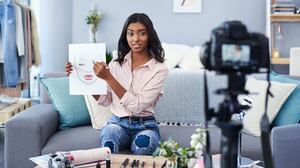Summer is fast approaching, and with people finally being able to take a beach trip with reduced fear of the pandemic (hello, vaccines!), here comes the sunscreen ads. The messages of “fun in the sun”, “get ready to sunbathe,” and “perfect sun protection” are all around the web and billboards.
One thing noticeable about these ads is the lack of targeted marketing toward people of color. According to a recent Consumer Reports survey of 2007 people, 61 percent of Black people and 23 percent of Hispanics said they never wear sunscreen. The unanimous consensus among skincare and cancer experts is that this is not wise.
While some might think that skin color can exempt them from having to worry about sun protection, the sun’s rays are an equal opportunity offender. While darker skin contains more melanin than lighter skin to help protect from sun damage, enough sun exposure can still cause skin damage and skin cancer.
Look around at sunscreen advertising, and you would think Black and Latinx people don’t use sunscreen at all. This helps perpetuate the myth that Black and Latinx people do not need sunscreen or aren’t buying it, but there is a slow shift in more people of color taking precautions to prevent sun damage to their skin.
Nicole Nance, an attorney and lover of skincare and beauty, told The Daily Beast, “Sunscreen companies that have failed to include people of color in their advertisements are failing us. Moreover, medical institutions have failed people of color. Public health information often overlooks or ignores Black people, even when Black people were the initial people studied for the disorder or issue. Companies that sell sunscreen need to not only show Black people, but also show what Black people who use sunscreen are concerned about. Is the sunscreen visible on dark skin? Does it leave a chalk white residue?”
By overlooking people of color in the broadcast and marketing of public health information, this leads to issues in both prevention and treatment of diseases like skin cancer.
Nance said, “Overlooking people of color in advertisements is a failure to them, but it’s also a failure to companies bottom line, because they’re missing out on an entire demographic of Black and brown people that could be potential customers.”
Nance says sunscreen falls at the intersection of both the beauty and healthcare industries, both of which she says have historically ignored and marginalized Black and brown people. “The myth that Black people can’t get skin cancer emanates from the same white supremacist thinking that Black people are inherently tougher and require less care. We need someone to combat that narrative; with the pervasive power of media and advertising, beauty companies that sell SPF products are in a unique position to both provide a public service for Black and brown communities while reaping a financial benefit.”
A 2019 CDC study found that sunscreen usage among Black and Hispanic people continue to be at low rates and misperceptions about the risks and benefits of skin cancer continue be perpetuated. Every year 1 in 10 Black people and 1 in 4 Hispanic people will get a sunburn.
Dr. Jennifer Berktold, principal research scientist at NORC at University of Chicago, an independent social research organization, was one of the researchers on the study. She found that many Black and Hispanic people don’t feel personally at risk of skin cancer, and part of that reason is they didn’t think they could get sunburned.
“In the study, I found there was definitely a need for people to have more information that it is possible for people with darker skin tones to get sunburned,” Dr. Berktold said. “While rates for sunburn and skin cancer for Black and Hispanic people are lower, fatalities happen at a different rate because they don’t get diagnosed with things like melanoma as early.
“What we found is when presented with messages about sun protection, both African American and Latinx audiences asked, ‘Is this meant for me?’”
Dr. Berktold added, “Information around skin protection is often perceived as a problem for white people. Black and Latinx people responded best to messages about sun safety from media resources specifically targeted toward people of color, such as blackdoctor.org for African Americans and Univision for Hispanics. Also, when folks were looking for product reviews for sunscreen products, they were quick to find product reviews where people were similar to them mentioning their skin tones and what worked well for them.”
Conversely, Dr. Berktold found that when people saw an absence of people who looked similar to them in advertising, they no longer felt the need to pay attention.
According to Dr. Bertkold, a fair amount of traction around discussion of sunscreen usage for people of color was seen after the survey was published. People in communities like Miami and Los Angeles, which have large Black and Hispanic populations, became more curious about UV rays and skin cancer awareness.
Some beauty influencers feel that the sunscreen industry has done a good job of making improvements over the past year.
Leslie Alvarado, a Mexican American beauty influencer based in Los Angeles, California, constantly reminds her substantial social media audience about the important of protecting your skin from sun. She recently landed a campaign for Supergoop! sunscreen, breaking ground for Latinx influencers in sunscreen campaigns. While Alvarado is now a dedicated advocate for the need to protect your skin from sun damage, when she was growing up that wasn’t always the case.
“When I was younger and I started playing sports I started getting a lot of sunspots on my skin,” Alvarado said. “I remember going to the doctor and they told me I needed to start wearing sunblock, and even then, my parents treated it like it was not a big deal. It wasn’t until after college that I started using SPF skincare products seriously.”
Alvarado found that many sunscreen ads today focus on the anti-aging aspect of sunscreen, telling women wear it to prevent wrinkles.
“There’s a whole anti-aging aspect to sunscreen ads now,” Alvarado said. “They are targeting whole aging aspect as opposed to telling people not protecting your skin from the sun is bad for you. There’s a skin cancer risk from not protecting yourself.”
In trying to address diversity issues, brands like Laura Mercier and Smashbox are offering tinted moisturizers with SPF to address a range of skin tones. These products have found huge popularity among women of color who are thrilled to have moisturizers that don’t leave them looking chalky or too shiny and protect them from the sun’s rays.
Neutrogena, which is produced by one of the largest sunscreen manufacturers in the United States, Johnson & Johnson, recently launched the Purpose program to help address diversity and inclusivity within the skin health industry. The brand’s new marketing message, “For People with Skin,” is targeted at people who are disproportionately impacted by skin health disparities due to factors such as socioeconomic status, race and ethnicity, and access to healthcare as found in the company’s research.
Neutrogena found that 47 percent of dermatologists felt their training did not prepare them to treat Black skin. Not only are professionals not receiving enough training, but consumers themselves feel they lack the expertise on how best to take care of their own skin needs.
“To combat this societal barrier, Neutrogena is committed to ensuring equitable and accessible skin products for all consumers using an inclusive approach to identify key insights that drive meaningful product innovations and relevant claims in products that are safe for all consumers across the full Fitzpatrick scale of skin tones,” a spokesperson for Neutrogena said.
The Fitzpatrick scale of skin types was developed in 1975 and classifies skin according to the amount of pigment and its reaction to sun exposure.
“The brand will also expand upon its existing partnership with the Johnson & Johnson Innovation's Black Innovators in Skin Health QuickFire Challenge, which awards one grant winner up to $50,000 to continue their work to advance science for products dedicated to skin of color,” the spokesperson added.
Dr. Berktold says the simplest solution to challenging these myths around skin cancer and skin tone and poor marketing is “just getting the message out. Everybody can be engaging in sun protection practices. Skin cancer can affect everybody. Everyone is at risk, and those types of messages need to get out. People need to hear more stories from people of their own backgrounds to bring awareness to these issues.”





